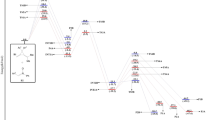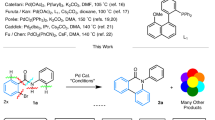Abstract
Kinetic data of the cyclohexene hydroxymethoxycarbonylation catalyzed by bis(triphenylphosphine) palladium Pd(PPh3)2 were processed and considered on the basis of the quantum-chemical calculations. By the method of density functional DFT PBE/3z we found that among the possible catalyst moleculs based on the tetrakis(triphenylphosphine)palladium the most stable is Pd(PPh3)2 with the coordination number of palladium equal 2. The interaction energy of Pd(PPh3)2 with acetone, acetonitrile, dichloroethane, 1,4-dioxane, nitromethane, and tetrahydrofuran calculated by PM3 method was found to correlate linearly with the reaction rate logarithm. The mechanism of the solvent effect on the reaction rate consists in a specific complexation with the catalyst depending on the molecule rigidity and the creation of energetic and steric constraints for the substrate to access the catalyst.
Similar content being viewed by others
References
Kiss, G., Chem. Rev., 2001, vol. 101, no. 11, p. 3435.
Lebedev, N.N., Khimiya i tekhnologiya osnovnogo organicheskogo i neftekhimicheskogo sinteza (Chemistry and Technology of Basic Organic and Petrochemical Synthesis), Moscow: Khimiya, 1988.
Petrov, E.S. and Noskov, Yu.G., Ross. Khim. Zh., 1998, vol. 42, no. 4, p. 149.
Noskov, Yu.G., Simonov, A.I., and Petrov, E.S., Kinetika i Kataliz, 2000, vol. 41, no. 4, p. 564.
El Ali, B. and Fettouhi, M., J. Mol. Catal., A: Chem., 2002, vols. 182–183, p. 195.
El Ali, B. and Alper, H., J. Mol. Catal., 1992, vol. 77, no. 1, p. 7.
Aver’yanov, V.A., Batashev, S.A., Sevost’yanova, N.T., and Zarytovskii, V.M., Kataliz v Promyshlennosti, 2005, no. 2, p. 25.
Vavasori, A., Cavinato, G., and Toniolo, L., J. Mol. Catal., A: Chem., 2001, vol. 176, nos. 1–2, p. 11.
Aver’yanov, V.A., Nosova, N.M., and Lebedev, K.S., Izv. VUZov, Ser. Khimiya i Khim. Tekhnol., 2009, vol. 52, no. 6, p. 28.
HYPERCHEM-8.0.8. Permanent Site License Version — Small School — Departmental (Class C), www.hyper.com.
Laikov, D.N., Candidate Sci. (Phys.) Dissertation, Moscow, 2000.
Laikov, D.N. and Ustynyuk, Yu.A., Izv. Akad. Nauk, Ser. Khim., 2005, no. 3, p. 804.
Jiro Tsuji, Palladium Reagents and Catalysts. Innovations in Organic Synthesis, New York: John Wiley & Sons, 1998.
Sergienko, V.S. and Porai-Koshits, M.A., Zh. Strukt. Khim., 1987, vol. 28, no. 4, p. 103.
Andrianov, V.G., Akhrem, I.S., Chistovalova, N.M., and Struchkov, Yu.T., Zh. Strukt. Khim., 1976, vol. 17, no. 1, p. 135.
Urata, H., Suzuki, H., Morooka, Y., and Ikawa, T., J. Organometal. Chem., 1989, vol. 364, nos. 1–2, p. 235.
Noskov, Yu.G. and Petrov, E.S., Kinetika i Kataliz, 1994, vol. 35, no. 2, p. 728.
Kron, T.E. and Petrov, E.S., Neftekhimiya, 2003, vol. 43, no. 6, p. 412.
Aver’yanov, V.A., Batashev, S.A., and Sevost’yanova, N.T., Neftekhimiya, 2008, vol. 48, no. 4, p. 286.
Noskov, Yu.G. and Petrov, E.S., Izv. Akad. Nauk, Ser. Khim., 2001, no. 10, p. 17.
Seyad, A., Jayasree, S., Damodaran, K., Toniolo, L., and Chaudhari, R.V., J. Organometal. Chem., 2000, vol. 601, p. 100.
Salem, L., Electrons in Chemical Reactions: First Principles, New York: John Wiley & Sons, 1982.
Author information
Authors and Affiliations
Corresponding author
Additional information
Original Russian Text © A.I. Ermakov, V.A. Averyanov, E.M. Kazakov, N.T. Sevost’yanova, 2011, published in Zhurnal Obshchei Khimii, 2011, Vol. 81, No. 4, pp. 570–575.
Rights and permissions
About this article
Cite this article
Ermakov, A.I., Averyanov, V.A., Kazakov, E.M. et al. Mechanism of the solvent effect on the rate of the cyclohexene hydroxymethoxycarbonylation catalyzed by bis(triphenylphosphine)palladium. Russ J Gen Chem 81, 663–668 (2011). https://doi.org/10.1134/S1070363211040074
Received:
Published:
Issue Date:
DOI: https://doi.org/10.1134/S1070363211040074




